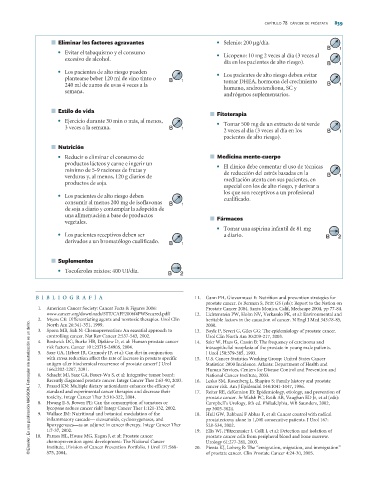Page 822 - medicina-integrativa_compress
P. 822
CAPÍTULO 78 CÁNCER DE PRÓSTATA 839
■ Eliminar los factores agravantes • Selenio: 200 μg/día.
B B 1
• Evitar el tabaquismo y el consumo
• Licopeno: 10 mg 2 veces al día (3 veces al
excesivo de alcohol.
día en los pacientes de alto riesgo). B B 1
• Los pacientes de alto riesgo pueden
• Los pacientes de alto riesgo deben evitar
plantearse beber 120 ml de vino tinto o B B 1 tomar DHEA, hormona del crecimiento
240 ml de zumo de uvas 4 veces a la humano, androstendiona, SC y B B 1
semana.
andrógenos suplementarios.
■ Estilo de vida
■ Fitoterapia
• Ejercicio durante 30 min o más, al menos,
• Tomar 500 mg de un extracto de té verde
3 veces a la semana. B B 1
2 veces al día (3 veces al día en los B B 1
pacientes de alto riesgo).
■ Nutrición
• Reducir o eliminar el consumo de ■ Medicina mente-cuerpo
productos lácteos y carne e ingerir un • El clínico debe comentar el uso de técnicas
mínimo de 5-9 raciones de frutas y de reducción del estrés basadas en la
verduras y, al menos, 120 g diarios de meditación atenta con sus pacientes, en B B 1
productos de soja.
especial con los de alto riesgo, y derivar a
los que son receptivos a un profesional
• Los pacientes de alto riesgo deben
cualificado.
consumir al menos 200 mg de isoflavonas B B 1
de soja a diario y contemplar la adopción de
una alimentación a base de productos ■ Fármacos
vegetales.
• Tomar una aspirina infantil de 81 mg
• Los pacientes receptivos deben ser a diario. B B 2 2
derivados a un bromatólogo cualificado.
B B 1
■ Suplementos
• Tocoferoles mixtos: 400 UI/día.
B B 2 2
BIBLIOGRAFÍA 11. Gann PH, Giovannucci E: Nutrition and prevention strategies for
prostate cancer. In Berman S, Britt GS (eds): Report to the Nation on
1. American Cancer Society: Cancer Facts & Figures 2006: Prostate Cancer 2004. Santa Monica, Calif, Medscape 2004, pp 77-84.
www.cancer.org/downloads/STT/CAFF2006f4PWSecured.pdf/ 12. Lichtenstein PW, Holm NV, Verkasalo PK, et al: Environmental and
2. Myers CE: Differentiating agents and nontoxic therapies. Urol Clin heritable factors in the causation of cancer. N Engl J Med 343:78-85,
© Elsevier. Es una publicación MASSON. Fotocopiar sin autorización es un delito.
North Am 26:341-351, 1999. 2000.
3. Sporn MB, Suh N: Chemoprevention: An essential approach to 13. Boyle P, Severi G, Giles GG: The epidemiology of prostate cancer.
controlling cancer. Nat Rev Cancer 2:537-543, 2002. Urol Clin North Am 30:209-217, 2003.
4. Bostwick DG, Burke HB, Djakiew D, et al: Human prostate cancer 14. Sakr W, Haas G, Cassin B: The frequency of carcinoma and
risk factors. Cancer 101:2371S-2490S, 2004. intraepithelial neoplasia of the prostate in young male patients.
5. Saxe GA, Hébert JR, Carmody JF, et al: Can diet in conjunction J Urol 150:379-385, 1993.
with stress reduction affect the rate of increase in prostate specific 15. U.S. Cancer Statistics Working Group: United States Cancer
antigen after biochemical recurrence of prostate cancer? J Urol Statistics: 2000 Incidence. Atlanta: Department of Health and
166:2202-2207, 2001. Human Services, Centers for Disease Control and Prevention and
6. Schacht MJ, Saxe GA, Bauer-Wu S, et al: Integrative tumor board: National Cancer Institute, 2003.
Recently diagnosed prostate cancer. Integr Cancer Ther 2:63-90, 2003. 16. Lesko SM, Rosenberg L, Shapiro S: Family history and prostate
7. Prasad KN: Multiple dietary antioxidants enhance the efficacy of cancer risk. Am J Epidemiol 144:1041-1047, 1996.
standard and experimental cancer therapies and decrease their 17. Reiter RE, deKernion JB: Epidemiology, etiology, and prevention of
toxicity. Integr Cancer Ther 3:310-322, 2004. prostate cancer. In Walsh PC, Retik AB, Vaughan ED Jr, et al (eds):
8. Hwang E-S, Bowen PE: Can the consumption of tomatoes or Campbell’s Urology, 8th ed. Philadelphia, WB Saunders, 2002,
lycopene reduce cancer risk? Integr Cancer Ther 1:121-132, 2002. pp 3003-3024.
9. Wallace JM: Nutritional and botanical modulation of the 18. Hull GW, Rabbani F Abbas F, et al: Cancer control with radical
inflammatory cascade— eicosanoids, cyclooxygenases, and prostatectomy alone in 1,000 consecutive patients. J Urol 167:
lipoxygenases—as an adjunct in cancer therapy. Integr Cancer Ther 528-534, 2002.
1:7-37, 2002. 19. Ellis WJ, Pfitzenmaier J, Colli J, et al: Detection and isolation of
10. Parnes HL, House MG, Kagan J, et al: Prostate cancer prostate cancer cells from peripheral blood and bone marrow.
chemoprevention agent development: The National Cancer Urology 61:277-281, 2003.
Institute, Division of Cancer Prevention Portfolio. J Urol 171:S68- 20. Pienta KJ, Loberg R: The “emigration, migration, and immigration”
S75, 2004. of prostate cancer. Clin Prostate Cancer 4:24-30, 2005.

